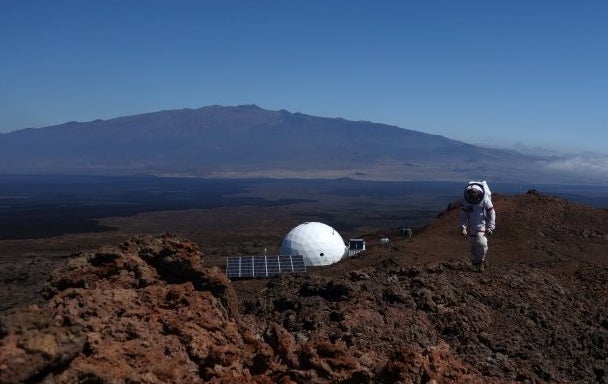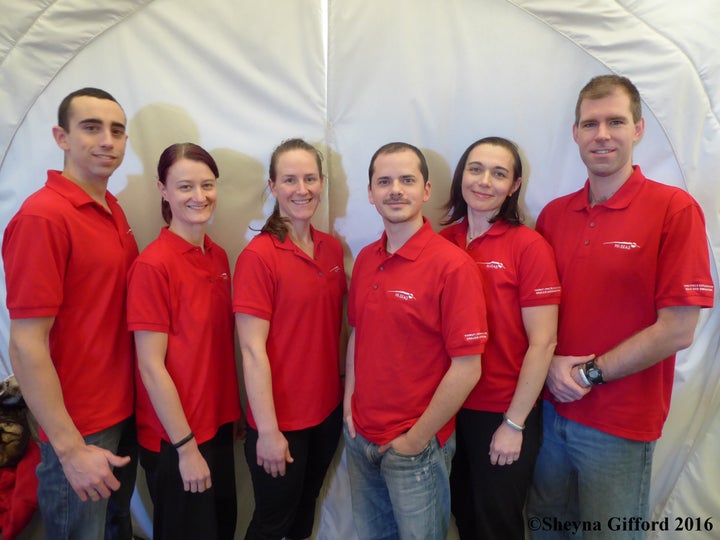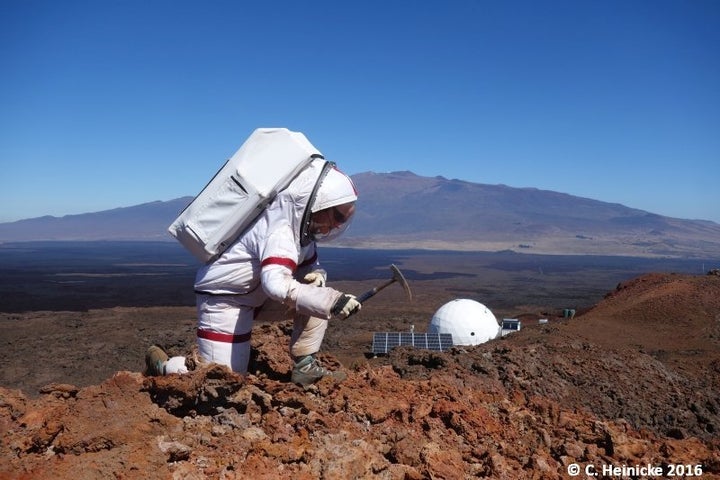
HONOLULU, Hawaii ― Sending humans to Mars presents enormous challenges, from the technological to the psychological.
Perhaps no one understands the mental test better than the team of international scientists who just spent a year living inside an isolated, Mars-like habitat atop Hawaii’s Mauna Loa volcano.
Sheyna Gifford, chief medical and safety officer of the fourth Hawaii Space Exploration and Analog and Simulation, or HI-SEAS, told The Huffington Post that the biggest challenges came from a “sense of helplessness.”
When things went wrong on Earth, whether it was a terrorist attack, flooding in Louisiana or a family member’s death, “trying to find a way to help from here is very difficult,” Gifford said.
On Sunday, the six-man crew will emerge from their dome free of spacesuits for the first time in 365 days, bringing to a close the longest space travel simulation ever conducted on U.S. soil.
In the days leading up to what Gifford called their “return to Earth,” HuffPost spoke with the crew, who have given the last year of their lives to preparing humans for life on Mars. Communicating via email and voice recordings, which were delayed 20 minutes to simulate communication in deep space, the HI-SEAS crew shared everything from personal hardships and plans for the future to the realization that humans are capable of anything.
Since entering the habitat on Aug. 28 of last year, HI-SEAS members have only been allowed to venture outside while dressed in full spacesuits.

In the hustle and bustle of everyday life on Earth, a year can seem to fly by. But isolate yourself to a 1,000-square-foot dome on rocky terrain 8,200 feet above sea level ― or perhaps in the future, in a small habitat on Mars ― and one might expect time to drag on.
Luckily, the NASA-funded mission kept the HI-SEAS crew busy with a rigorous daily schedule of scientific research, geological field work, equipment testing, cooking, exercise and much more.
Crew Commander Carmel Johnston said so much happens on simulated Mars that at times “you are just trying to keep your head above water.”
The idea that the team has been up there an entire year, Gifford added, is “almost absurd.”
“It doesn’t feel like a year, I think that’s the strangest part. It feels like we’ve been here a few months,” she said, adding a person’s sense of time progresses completely differently.
That’s not to say the last 12 months have been a breeze. Beyond obvious things, like missing fresh food and the wind on your face, time away from Earth presents enormous emotional challenges. And that’s one of the main goals of the simulated journey: to better understand the risks associated with space travel, including conflict, stress and depression.
For example, Gifford’s grandmother died about a month ago. Although her death was expected, Gifford said not being there for her family was extremely difficult.
“I said goodbye to my grandmother over a delayed video message,” she told HuffPost. “That’s not something any of us ever want to do. So simply not being on Earth, I think everyone would agree, is the most challenging part of space.”
Johnston said she struggled with the “out of sight, out of mind” treatment she received from people who she expected would stay in touch.
“We changed everything about our lives and limited ourselves to only communicating by email,” she said. “If anyone didn’t want to hop on that wagon, we just didn’t hear from them this year. It can be pretty disheartening to feel like you are missing out on everything happening at home.”
Tristan Bassingthwaighte, the crew architect, told HuffPost he often felt “bored to death.” Other times he just wanted to be alone, to find a place to get away.
“A person can be totally cool one minute and severely annoying the next,” he said in an email. “The little things people do that you’d never notice in real life can make you think about tripping them on the stairs here.”
Ultimately, it’s how they dealt with such situations and interacted with one another that’s of interest to NASA, which hopes to send astronauts to Mars at some point in the 2030s. Using cameras, body movement trackers and electronic surveys, researchers gathered data on a wide range of cognitive, social and emotional factors that could affect team performance during an extended mission to Mars.

Surprisingly, the crew said that at no point did they ever feel like giving up, leaving their false, faraway world to return to Earthling life. When they did get bored or had down time, they found ways to keep busy.
An avid reader, Bassingthwaighte said books were his “little doors to worlds that aren’t this one.” He’s also been working on Doctor of Architecture degree and learned to cook with the limited resources he has available. He lost 20 pounds while in the habitat.
Gifford, who also served as crew journalist, published numerous online articles, including several blogs for HuffPost.
The big question moving forward is what researchers can learn from the mission. The crew itself has no doubts that their sacrifices will help humans reach Mars.
“With all the good and the bad comes lessons that you can’t learn unless you are in isolation,” Johnston wrote. “Every success or failure is still data and an outcome that can be used to improve the lives of astronauts and Martians.”
“We still need to make the ships and bases (Looking at you SpaceX, I’m available) and understanding this will help us make them right,” Bassingthwaighte wrote. “After that, a little time and effort and we’ll have people on Mars in no time.”
Counting down to their so-called “re-entry,” the crew had their sights set on everyday things we Earthlings take for granted ― hugging loved ones, feasting on a burger, swimming in the ocean and running on grass.
In addition to spending time with family and getting outside, Bassingthwaighte’s said he’s looking forward to living in a place with a window.
“I mean holy crap! A whole window that belongs just to me?” he wrote. “I don’t even know what to do with that, we’ve all been sharing a window the size of a medium pizza for the last year.”
In her time away, Gifford said she’s come to realize that the journey to Mars will likely prove more challenging in ways we don’t expect than in ways we do. The good news, she said, is “human beings are pretty much capable of anything.”
There’s one other point that Bassingthwaighte said he wants to clear up once and for all: The HI-SEAS crew is not actually on Mars, and they are not being sent to Mars.
“You’d be amazed at how many people don’t get that,” he wrote.

